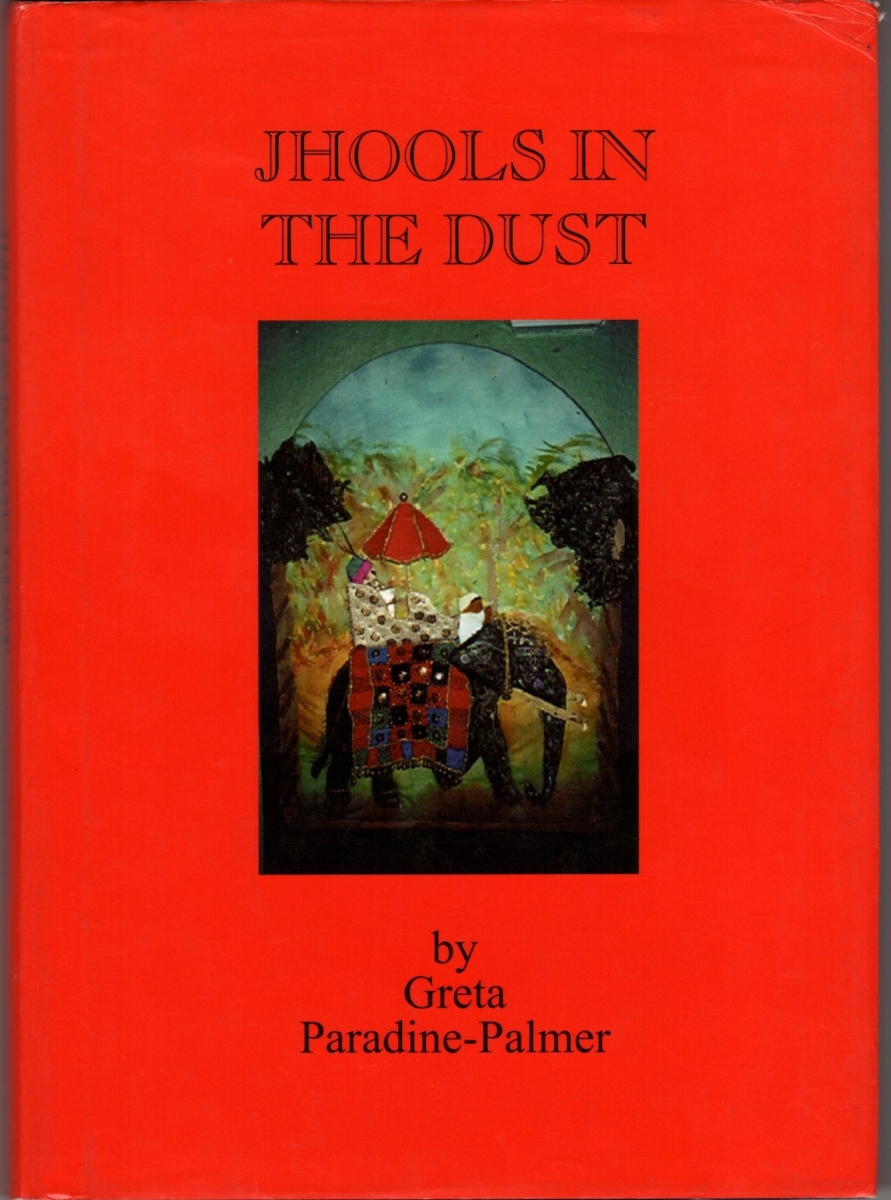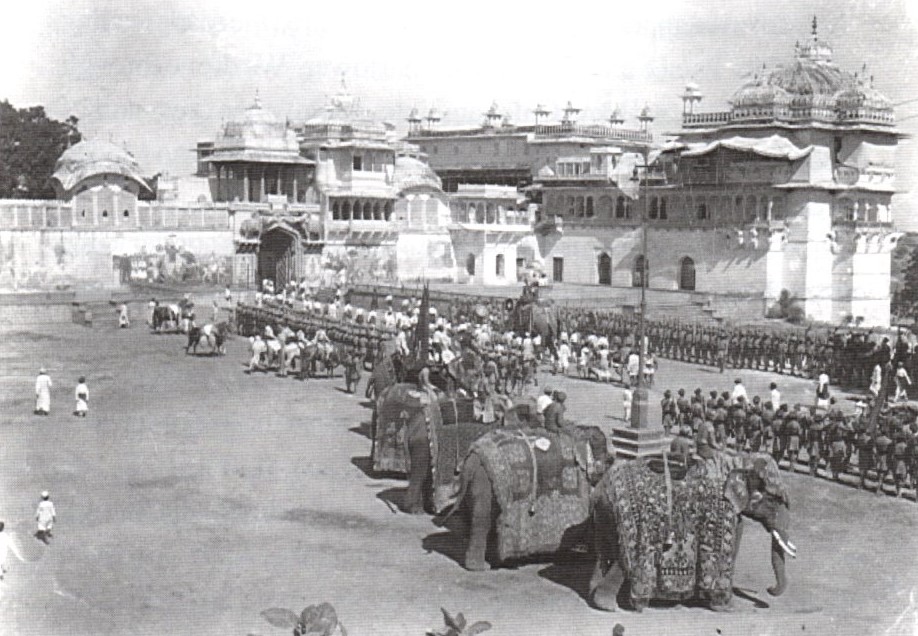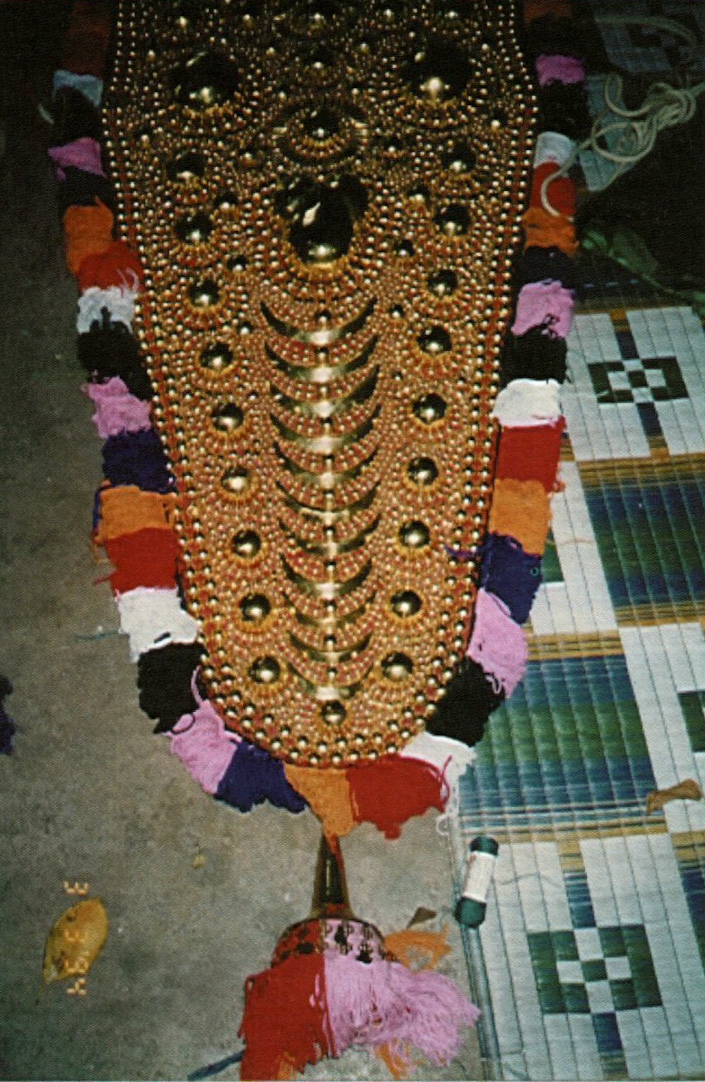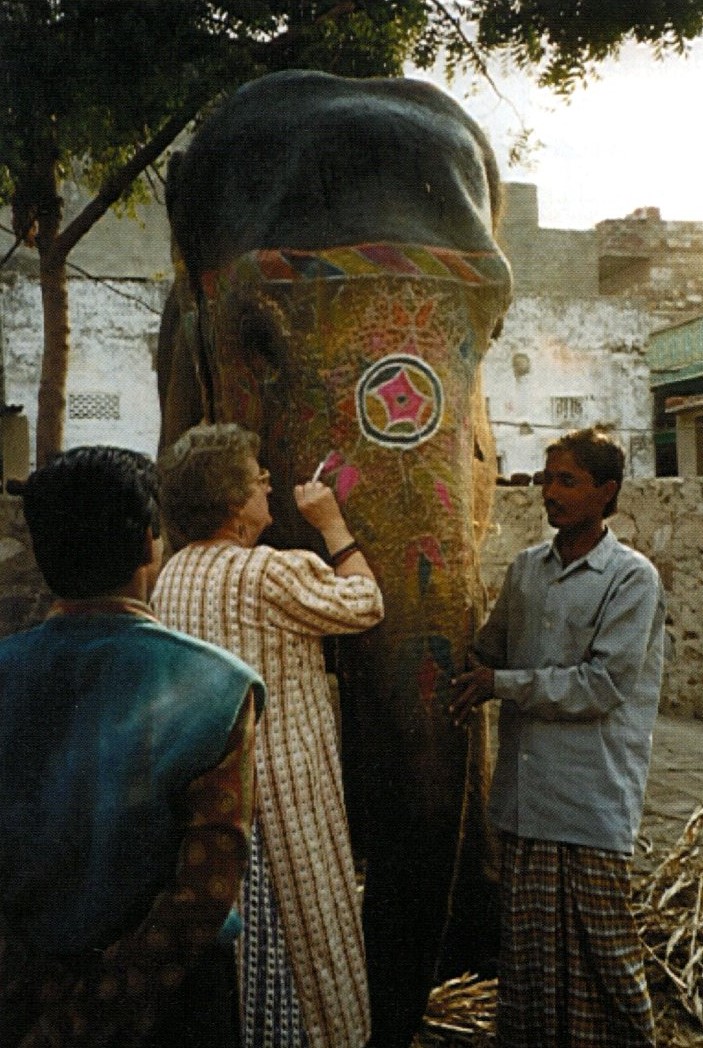Greta Paradine-Palmer born in Northampton in September 1936. In 1951, she started working at Manfield Shoe Manufacturer as a comptometer operator. In 1990, she enrolled in a course in ‘City & Guilds Creative’, which allowed her to research on accoutrements of elephants. This is what first brought her to India in 1993 and thereafter she made numerous visits to the subcontinent to study elephant regalia. During her visits she meticulously recorded every detail of the collection held by different museums which she documented in her book Jhools in the Dust (2002).
Over the past 20 years she has been travelling around England lecturing on her experiences on the field. She is no longer working with textiles but has taken up painting and mask-making based on her Indian experience.
Shakshi Gupta: How did your association with elephant regalia begin?
Greta Paradine-Palmer: In 1990 I began a City & Guilds Creative Study course at the local Technical College. The course consisted of two parts. After passing Part 1, I began Part 2. The syllabus was to find an object of my own choosing, research, photograph, write 750 words on the subject before designing and making a piece of embroidery. I chose a wooden Indian elephant as I liked the carved design on the back. This was the start of my involvement with India and elephant regalia.
S.G.: Not many people are aware about elephant regalia, in your view what is it, how did it evolve as an art and become an important aspect of royal life?
G.P.: I think you are right. People today do not seem to understand the importance of decoration, it is too easy to turn on any form of media and have an instant answer. In history all form of decoration were important and the heads of States such as a maharaja wanted to show their power and wealth to their people and what was more impressive than a fully caparisoned (dressed) tusker? I’m sure the spectacular sight would have been a very strong influence.
S.G.: This research demanded intensive field study in India. How was your journey? Were there any difficulties? What keeps you going? Were there any advisors?
G.P.: I spent several weeks in India, first in Rajasthan with Dr Mahendra Singh Naggar director at The Mehrangarh Fort Museum, Jodhpur, where I was given access to the private collection and the library. I lived with Mahendra and his family for the time I was there and was privileged to become part of the family. I learnt so much from him, not only about the elephant dress but the customs and lifestyles of the Indian people and through him I met many interesting people. I also travelled to Udaipur where I met and questioned Maharana Arvind Singh and his A.D.C. (aide-de-camp) and then on to Jaipur where I was given access to the private collection in the Palace. From here I flew to Kerala where I found things a little more difficult as I didn’t have any advisors.
S.G.: You wrote a book titled Jhools in the Dust. How you come up with this title? What inspired you to write a book on this subject?
G.P.: The idea for the title of my book came from a visit to Jaipur where Mr. Sahi, director of the Palace Museum, took me to a place in the palace for me to search records which may have contained information on a Hathi Khana. The area was surrounded on three sides with jali (lattice) screens and the floor was covered in sand. As we walked towards the shelves stacked with bundles of paper tied up in red string, I realized the sand was indeed dust so hence the title of the book.

Cover page of book titled as ‘Jhools in the Dust, © Greta Paradine-Palmer
S.G.: Were you able to get in touch with any craftsman who was or is still making the trappings or saddle cloth for the royalty? Could you tell us a little about the technique of crafting it?
G.P.: I did try to meet craftsmen who would have worked on the trappings but sadly they have died out. However, I learnt from Kurban Khan, one of the last mahouts employed by the Palace in Udaipur, that a group of eight to ten men were employed to make the jhool and seeri [saddle cloth and elephant trunk covering]. These gentlemen would perhaps come from Delhi where on arrival at the Palace would be locked in so that no one would be aware of the designs discussed, jewels, precious or semi-precious stones. The materials used were checked in the morning and again at night to ensure no one present could pocket any of the jewels. Before they began their work one man would be sent to measure the elephant. Beginning at the front leg, the measure was taken three feet off the ground, over the back and to three feet off the ground on the other front leg, one foot from the dumchi [crupper] and one foot from the withers. This would give the size of the finished article. Not all jhools were made from cloth; woven material and velvet were also used. It could take two to three months to make a jhool and matching seeri depending on what decorations were used.
I travelled to Barmer to meet carpenters who knew the process for making howdahs but I met no one who had actually made one. I also met carvers and I am sure they work in the same way as their ancestors. When the howdah was complete they would be employed to make the necessary patterns on the wood. Then a goldsmith would come to the Palace, beat out the gold and cover the carving, known as roussee work. I spoke to a goldsmith in Jodhpur, he knew techniques but there was no occasion to make items for elephants in the modern age.
The elephant would be washed and painted before being ‘dressed’, and as the parade left the palace with the Maharana aboard, the howdah the embroiderers, carpenters, carvers and jeweller would be released from the palace.

Return of royal elephants from Dassera procession, City Palace Kotah, Circa 1930. Source: Jhools in the Dust by Greta Paradine-Palmer, ©Kota Garh City Palace
S.G.: You not only travelled in the north but also visited South India. How is the decoration different between north and south?
G.P.: In Kerala the decoration of the elephant is very different. A red blanket is placed on the back of the elephant and the trunk sits a nettipattam, a decoration made by the official state decorator. Men sit on the back of the elephant, one carries an umbrella, another an arravattam, peacock quills plaited with shisha (mirror) inserts and feathers around the outside making a large fan. Yak’s tails are also used to keep off the flies.

Nettipattam, Head covering of elephant in South India. © Greta Paradine-Palmer
S.G.: Since then, the decoration of an elephant has changed a lot. What do you think about this?
G.P.: When the Maharajas lost their government allowances (1971) and their status the elephants were one of the expenses that had to go. No longer were there Hathi Khana with 99 elephants and over the years the elephants and Hathi Khana have become obsolete. Objects such as jhools that were covered in jewels were sold and maharajas turned their palaces into hotels. This period of history will not be seen again and we must make sure that, although perhaps not politically correct today, this symbol of strength and wealth is not forgotten.
Pheel Khana, Nagaur Fort. © Greta Paradine-Palmer
S.G.: If we move to the contemporary style of decoration, elephant riders do a lot of body art rather than decking up with rich embroidered cloth. What effect do you feel this might have on the elephant’s body?
G.P.: As far as I know the paint does not have any effect upon the hide of the elephant but having said that it might depend upon the type of paint being used. The original paintings were done with mineral paints, the stones found locally so knowledge of the geologist was important. Today commercial powder paint is used and I have not really looked into the outcome on the elephant.

Greta painting Laxmi watched over by Razak. © Greta Paradine-Palmer
S.G.: Do you think today there is any possibility of reviving this art and to increase the demand for elephant decorators in this high-tech world?
G.P.: I don’t think the tradition of dressing elephants as the Maharajas did will ever be revived in this hi-tech age. The Indians love elephants and use them for many ceremonial occasions I would imagine with all the high-tech knowledge someone will, one day, come up with a new idea of decorating elephants.












